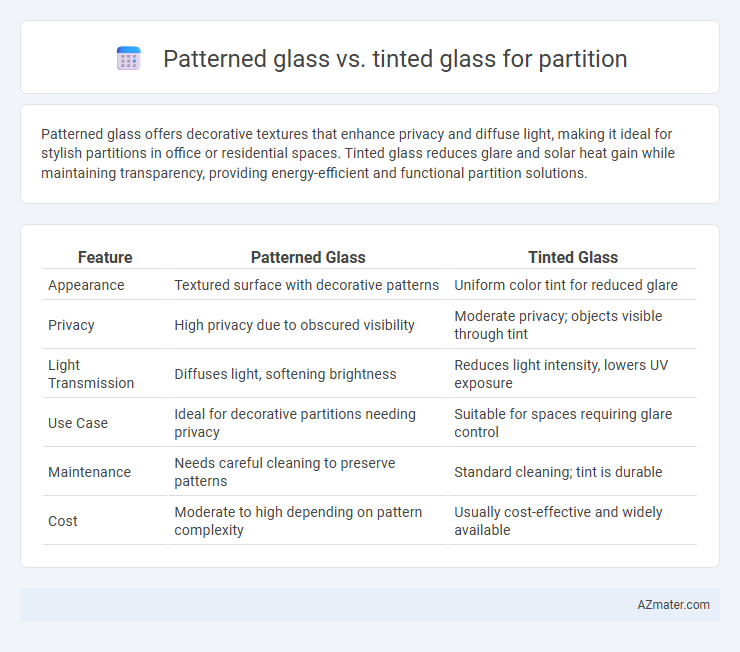Patterned glass offers decorative textures that enhance privacy and diffuse light, making it ideal for stylish partitions in office or residential spaces. Tinted glass reduces glare and solar heat gain while maintaining transparency, providing energy-efficient and functional partition solutions.
Table of Comparison
| Feature | Patterned Glass | Tinted Glass |
|---|---|---|
| Appearance | Textured surface with decorative patterns | Uniform color tint for reduced glare |
| Privacy | High privacy due to obscured visibility | Moderate privacy; objects visible through tint |
| Light Transmission | Diffuses light, softening brightness | Reduces light intensity, lowers UV exposure |
| Use Case | Ideal for decorative partitions needing privacy | Suitable for spaces requiring glare control |
| Maintenance | Needs careful cleaning to preserve patterns | Standard cleaning; tint is durable |
| Cost | Moderate to high depending on pattern complexity | Usually cost-effective and widely available |
Introduction to Glass Partitions
Glass partitions enhance interior spaces by providing transparency and light diffusion while defining separate areas. Patterned glass offers decorative textures that increase privacy and aesthetic appeal, making it suitable for office or residential partitions. Tinted glass reduces glare and solar heat gain, improving energy efficiency and comfort in partitioned environments.
What is Patterned Glass?
Patterned glass is textured or embossed glass designed with various decorative patterns that provide privacy while allowing natural light to pass through, making it ideal for partitions in offices and homes. Unlike tinted glass, which reduces light transmission by adding color, patterned glass enhances aesthetic appeal and obscures visibility without significantly darkening the space. Common patterns include rain, reed, and linen textures, offering both functional and stylistic benefits in interior design.
What is Tinted Glass?
Tinted glass is a type of glass that has been infused with metals or chemicals during manufacturing to reduce glare and control heat by absorbing a portion of the sunlight. This glass variant enhances privacy while providing UV protection and maintaining visibility, making it ideal for office or home partitions. Patterned glass, in contrast, incorporates textured surfaces to obscure visibility but does not significantly impact heat or glare control.
Aesthetic Appeal: Patterned vs Tinted Glass
Patterned glass offers a unique aesthetic appeal by incorporating intricate designs and textures that enhance privacy while adding decorative value to partitions. Tinted glass provides a sleek, modern look by reducing glare and controlling light transmission, creating a sophisticated ambiance with subtle color variations. Choosing between patterned and tinted glass depends on the desired balance between ornamental texture and minimalist elegance in partition design.
Privacy and Light Control Comparison
Patterned glass offers enhanced privacy by obscuring visibility while allowing ample natural light to filter through, making it ideal for partitions in office or residential spaces where confidentiality and brightness are essential. Tinted glass provides moderate privacy by reducing glare and controlling light intensity, but it allows more silhouette visibility, which may not be suitable for high-privacy areas. For optimal light control, patterned glass diffuses light evenly, minimizing harsh shadows, whereas tinted glass absorbs and blocks a portion of sunlight, effectively reducing heat and UV exposure.
Acoustic Performance Differences
Patterned glass offers moderate acoustic insulation by diffusing sound waves through its textured surface, reducing echo but not fully blocking noise transmission. Tinted glass provides minimal soundproofing benefits as its primary function is to reduce glare and heat rather than enhance acoustic performance. For partition applications requiring effective noise control, patterned glass is generally preferable over tinted glass due to its superior sound diffusion properties.
Safety and Durability Aspects
Patterned glass for partitions offers enhanced safety by obscuring visibility while maintaining strength through tempered or laminated options that resist shattering. Tinted glass provides UV protection and reduces glare, contributing to durability by minimizing fading and heat damage to interiors. Both types are designed to meet stringent safety standards, but patterned glass typically delivers superior privacy without compromising structural integrity.
Maintenance and Cleaning Requirements
Patterned glass for partitions requires minimal maintenance due to its textured surface, which helps mask fingerprints and smudges, reducing the frequency of cleaning. Tinted glass, by contrast, often shows dirt and streaks more clearly, necessitating more regular cleaning with non-abrasive, pH-neutral solutions to preserve the tint and prevent discoloration. Both glass types benefit from gentle cleaning methods, but patterned glass offers a practical advantage in high-traffic or office environments where ease of upkeep is essential.
Cost Comparison: Patterned vs Tinted Glass
Patterned glass generally costs more than tinted glass due to the intricate designs and manufacturing processes required. Tinted glass offers a more affordable option, providing basic light control and privacy without the added expense of decorative patterns. The choice between patterned and tinted glass for partitions depends largely on budget constraints and desired aesthetic features.
Which Glass is Best for Your Partition?
Patterned glass offers enhanced privacy and decorative appeal for partitions by diffusing light and obscuring visibility, making it ideal for office or bathroom partitions where discretion is needed. Tinted glass reduces glare and solar heat gain, improving energy efficiency and comfort in spaces exposed to direct sunlight while maintaining a clear view. Choosing the best glass depends on whether privacy or heat control is the priority; patterned glass suits privacy-focused partitions, whereas tinted glass is preferable for partitions requiring light control and energy savings.

Infographic: Patterned glass vs Tinted glass for Partition
 azmater.com
azmater.com